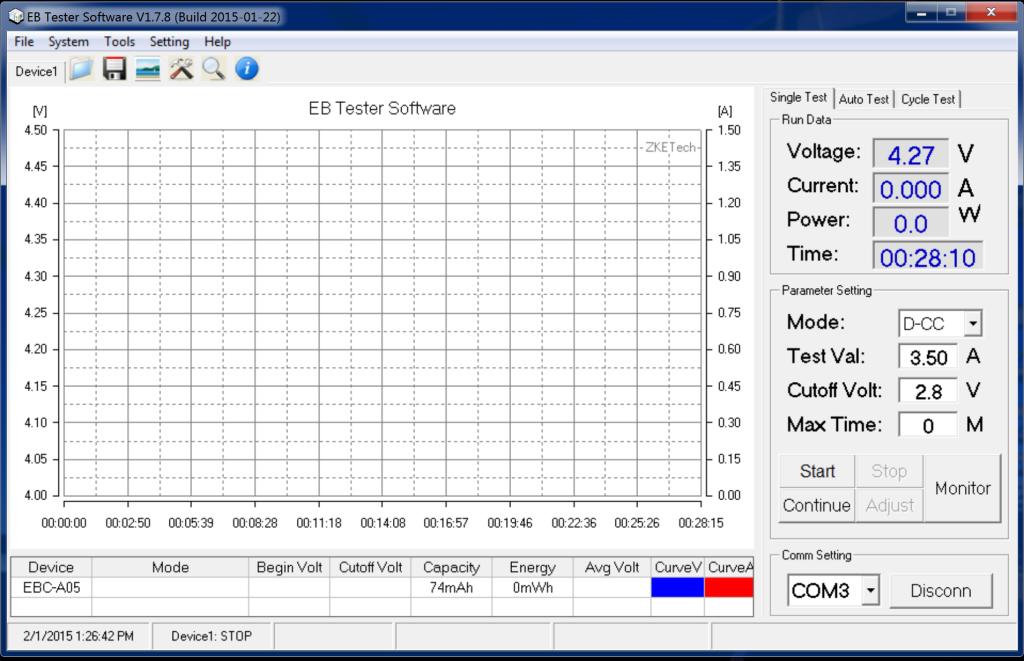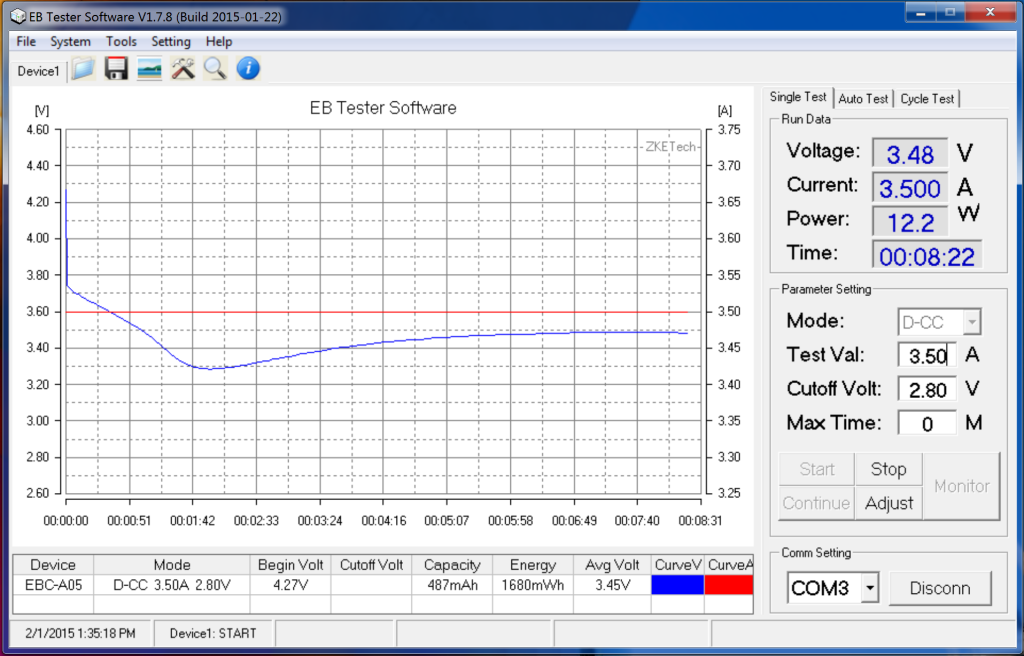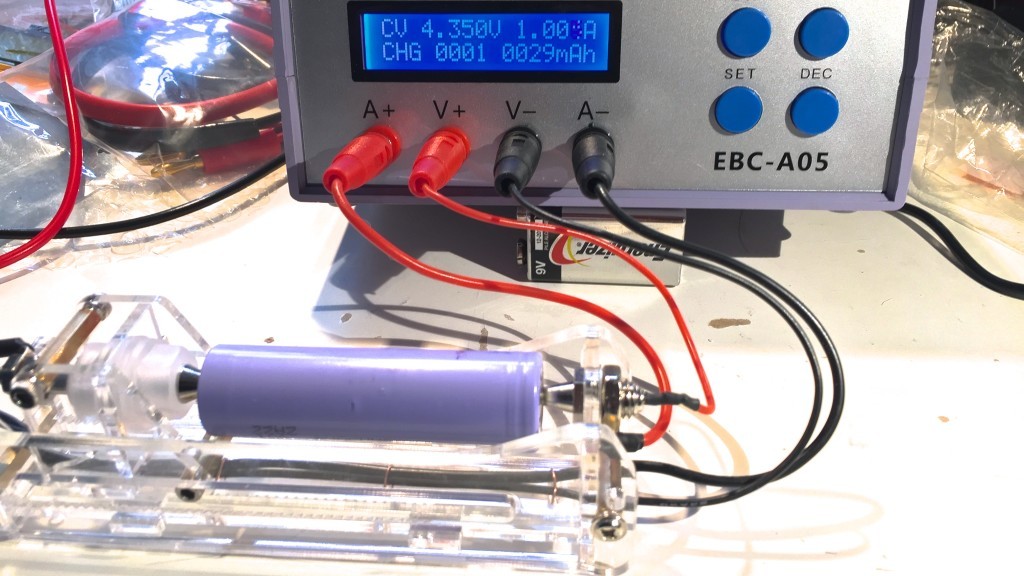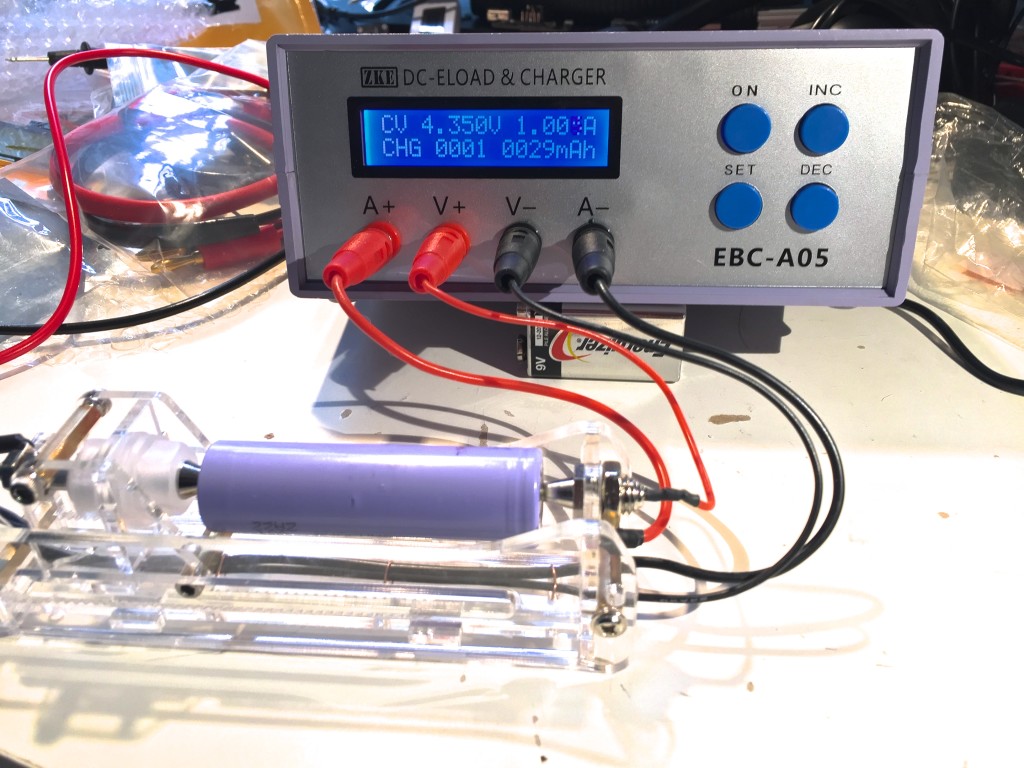I recently acquired a ZKE EBC-A05 DC electronic load and battery charger to use in testing lithium ion batteries.
This device has a nice set of features, including:
- 4-wire test interface, to minimize impact of load/charging current on reading battery voltage.
- Constant current or constant power load testing at up to 12v @ 5A.
- Battery charging for Lithium, NiMH and lead acid batteries at up to 3A.
- USB serial connection and windows software for data logging and charge/discharge control
I’ll be updating this page with a review, tests, and teardown of the device as I use the device.
Sourcing the Device
The EBC-A05 is one member of a line of battery testing equipment made by a Chinese company called ZKE that looks like it has been in business since 2006 or so. I think I first learned of them while rooting through some Chinese flashlight and battery forums with the aid of Google and Bing translate. I was intrigued because they seemed to combine a nice feature set at what, I assumed, was a reasonable price, if I could get one without paying a huge markup.
ZKE’s primary storefront is on TaoBao, but while TaoBao has recently started taking foreign credit cards, shipping can still be a challenge. I’ve seen some of their stuff on AliExpress, but AliExpress doesn’t allow orders from Washington State, where I reside, so I decided to source mine from Franky Tong. I found out about Franky through the EEVBlog forum, where he is a trusted member. He sells a selection of multimeters and test equipment and test leads through his 99centhobbies EBay shop, and also helps people source one-off components and equipment at a reasonable markup. For less than $60, and just about two weeks after I made my inquiry, I received a package with my order from Hong Kong. If you are interested in similar assistance, you can email franky (at) 99centHobbies (dot) com.
Operation
Standalone
The EBC-A05 is made to be used with PC software to log data and control multi-step test plans, but all the core charging and discharging functionality is available standalone, through the front-panel interface.
I found the interface relatively intuitive and easy to understand and use, though referring to google-translated version of the chinese documentation helped fill in some gaps.
Holding down the set button causes a blinking cursor to display in the upper-left section of the display responsible for indicating the operating mode. Hitting the inc/dec buttons will cycle forward and backwards through the operating modes. Each operating mode has additional parameters that can be set.
Discharge Modes
- DSC-CC: Constant current discharge
- DSC-CP: Constant power discharge
In addition to a setting for the discharge current or power, these modes have settings for terminating the test when the voltage drops to a user specified level, and/or exceeds a certain duration.
Standard Charging Modes
- CHG-NiMh/NiCd: NiMH & NiCd charging profiles
- CHG-Pb: Lead-acid charging profile
- CHG-LiPo: Lithium Ion charging profile (4.2v termination)
- CHG-LiFe: LiFePO4 charging profile
The user can specify a charging current, and the number of cells connected in series. The charge termination conditions are calculated based on the chosen chemistry, cells in series, and charging current. A maximum charging duration can also be set.
As an option, the user can choose to perform an automated three-step charge-discharge-charge test. When this option is chosen the user additionally specifics current and termination voltage for a constant-curren discharge test, along with a rest duration between test steps.
Special Charging Modes
- CHG-CV: Constant Voltage / Constant Current charging profile
This mode can be used to charge lithium ion cells to arbitrary termination voltages and termination currents. For example, you could use it to charge cells with a 4.3v or 4.35v termination voltage, and/or 1C fast charging current during the CV phase, while terminating the CC phase at 1/20C.
Charge duration can’t be limited in the mode, but the option to do a three-step test available in the other charging modes is also available here.
- CHG-PW
Provides 5V @ 2A max for charging USB devices.
PC Connected
The EBC-A05 can be connected to windows PC using an optional USB-TTL serial cable. When the EB Tester software is running on the PC, and the connection is initiated to the device, the front-panel inputs are locked out. The LCD continues to show the operating mode, voltage, current, but indicates the PC connection is active.
Single Step
The PC software can be used to configure and initiate a single-step test.

Once the test is running, it charts the current and voltage at ~1s intervals, and updates a summary of the current and power consumed during the test.
 The dip in the above example is unexpected and needs more scrutiny in later tests.
The dip in the above example is unexpected and needs more scrutiny in later tests.
The software allows export of a graphic, or a datafile.
Multistep
The software allows automation of multistep testing. I will update this section once I have the opportunity to try some multistep tests.


Oh nice…a graphing charger…will definitely be able to see the CC/CV pattern on batteries…does it list total mAh both on charge/discharge?
Nice review…thanks!
Hmm, I’m not actually sure what capacity the PC UI reports when you do a full charge/discharge cycle.
Before I do more testing, I’m waiting on a little refurb PC I ordered that I can use to run the software so I don’t have to leave my laptop connected.
Hi,
nice preview.Please report further, i am considering to buy the 8 channel battery tester.There is also option for customization and 4 channel tester as well.
Greets!!
Hey Peter, thanks for your interest. Sorry I didn’t see your comment until just now. I haven’t made as much progress writing about this thing as I’d planned, but I’ve been running it almost constantly for the past few weeks and it seems to be holding up well and delivering useful data.
Interested to hear about your plans for the 8-channel tester. I’m considering either buying a few more of these, or getting the 8-channel tester myself.
I’m thinking about organizing a group buy for some of these too.
Hi.
I’ve bought that charger while ago via Aliexpress but mine charger doesn’t come with TTL serial mini USB cable for PC connection. Can you tell me from where you find that PC cable or if you have any pinouts if it i will try to made it myself.
I bought a package that included the TTL cable. I’m not sure the pin-out, but I bet it would be easy to figure out if you opened the case and looked at the markings on the PCB.
Hi!
We want buy an electronic load EBD-A20H for testing power supplies. We do not need charging function… We need only a function of electronic load.
How well this device for testing power supplies?
Thank you
Georg, I haven’t characterized this device in much depth, so I can’t really say how suitable it is for testing power supplies. I will say that the design seems pretty simple, and battery focused, so it might have unpredictable/unexpected behavior as a load with another type of power supply.
Thanks for your answer. I made custom usb cable from old Nokia data cable which have same chip as ZKE TTL serial cable. Also I done reverse engineering part of the schematic of EBC-A05. Also I need to made other some test of Electronic load fuction for testing the power supplies.
Eas do you know is possible to use the Auto test function in EB software with EBC-A05. Every time when i tried to set up that test the software chashed.
Also tried the chinese version of EB but there is the same result.
If someone interesting how to upgrade firmware of EBC-A05 the trick is to run the device in firmware upgrade mode. Just hold pressed ON button until you plug DC jack in device. After that the EBC-A05 will be in firmware upgrade mode. For that you must choose firmware upgrade tool from EB software. Before run in upgrade mode choose proper COM port for connection but do not connect to the device.
I tried out the Auto Test function shortly after getting the unit. I didn’t have any problem with it.
Hi
Is there a chance you can send me the schematics?
BR
David.
Hi, thanks for the info. Can you post picture of the inside details of the device?
Yeah, I’m way overdue on the next installment of the EBC-A05. I actually have some of the EBC-A10 devices too.
i’m buy EBC-A05..
My PC install software and run is ok.
i see EN manual but Protocol no write..
i can make serial communication program.
Can I download the protocol documentation?
I haven’t seen any protocol documentation.
I’ve been meaning to hook mine up while I have a serial-port monitor running so I can reverse engineer the protocol, but my attention has been elsewhere lately.
Hi again,
i didn’t buy the 8 channel discharger, but the ebc-a10.It has similar functions as yours, but the discharge current is 10a max.Also it has the option to connect sd card slot to store data and bluetooth conectivity.For that you should do some tweaks which you can find on the chinese http://www.chongdiantou.com
forum.The link for the tutorial is also on the zke taobao page.
Anyway the device suits perfectly my needs, didnt play alot with it.Waiting to get a tesla cell and some other 3500mah cells.
By the way i could not run it under windows 8.1, only windows 7 VM mashine.
Greets Peter.
Thanks for the report, Peter.
I have a couple of EBC-A10s as well. They are quieter than the A05, even when doing 10A discharges, which surprised me.
I’d seen people beta testing the SD Card module on http://www.chongdiantou.com months ago, but I was starting to wonder if they’d ever actually start selling it.
A warning, these things don’t have reverse discharge protection. I put a cell in backwards and didn’t notice it immediately and it discharged fully. It seems to have damaged a component so now there are intermittant problems with leakage current. I started to troubleshoot the failed component, but didn’t get very far.
Another warning, triple check the settings! I also accidentally overcharged a cell to 5.2v due to a typo and being in too much of a hurry to notice it.
serial-port monitor running. And
reverse engineering protocol get.
So I make BMS software
thanks.
Could you please send me the protocol (for comparison with my inspection)?
A good program for EBC-A05 (for Widows) I am also very interested …
Thanks.
Hi. Sorry, I’m currently working on other projects and am not doing anything with my EBC-A05 right now. To be clear, I have no information on the protocol. I thought I might try to reverse-engineer it if someone else doesn’t do it first.
Hey KSY,
I am in need of also trying to communicate with my EBC as well. Could you please provide me any reference of how can I get to communicate with the device?
I saw your emssystems1234 page, and that is exactly what I need to do, your help will be very much appreciated.
Ant images of the inside? I’m very curious about the PCB layout. Thanks.
“Ant images of the inside?”
a little:
https://yadi.sk/d/v387M6gEjCTNX
Something about the ZKE EBC-A05 (in Russian):
https://yadi.sk/d/-XR1tNlyjUsry
my C# Code..
// ConnectPacket & DisConnectPacket
byte[] ConnectPacket = { 0xfa, 0x05, 0x00, 0x00, 0x00, 0x00, 0x00, 0x00, 0x05, 0xF8 };
byte[] DisConnectPacket = { 0xfa, 0x06, 0x00, 0x00, 0x00, 0x00, 0x00, 0x00, 0x06, 0xF8 };
// [start[1byte], mode[1byte], current[2byte](mA), cutoffV[2byte](input value is Setting values +16), Time(min)[2byte], xorChecksum[1byte], end[1byte]]
byte[] DisChargeConstantCurrentStopPacket = { 0xfa, 0x02, 0x00, 0x00, 0x00, 0x00, 0x00, 0x00, 0x02, 0xF8 };
// C-CV
// fa 71 00 64 00 c8 04 28 01 f8
// C-NiMh
// fa 21 02 78 00 05 00 0a 54 f8 (current 60mA, Cells 5, Max Time 10)
// C-NiCD
// fa 31 02 78 00 05 00 0a 44 f8 (current 60mA, Cells 5, Max Time 10)
// C-LiPo
// fa 41 02 78 00 05 00 0a 34 f8 (current 60mA, Cells 5, Max Time 10)
// C-LiFe
// fa 51 02 78 00 05 00 0a 24 f8 (current 60mA, Cells 5, Max Time 10)
// C-PB
// fa 61 02 78 00 05 00 0a 14 f8 (current 60mA, Cells 5, Max Time 10)
this data is directly obtained through reverse engineering..
you can see my work.
https://sites.google.com/site/emssystems1234/
Cool! Thanks for sharing your code and posting the link to your work.
O.K., I liked the write up so I went and got a ZKE EBC-AO5…
Now I want to know how to access an instruction booklet, and perhaps the program for a lap-top…
I have not figured out how to access most of the functions =(
for example, how to tell it if I want to charge a lead-acid or a Li battery… basically everything it can do seems hard for me to figure out and any help will be vastly appreciated!
even if it is just directions to a web-page that I’ll need to translate… (least favorite option, of course, but better than nothing!)
Thanks for any guidance!!
I recently bought the EBC-A05 and so far the unit seems pretty good, but the package did not include the software and I have not been able to download it from the ZKE site. Can someone post a link that works or point me in the right direction? Thank you for any help you can provide.
I’ve downloaded the software from ZKE BLOG: https://pan.baidu.com/s/1o8jepAi
But I’m not sure if you’ll be blocked overseas.
Who makes the battery holder (foreground in the picture)? Where can we buy one ? It looks like a nice custom job there.
I found it. In case someone else is also interested. Here is the link.
https://m.fasttech.com/products/1425/10015615/2955600-4-wire-battery-charge-discharge-fixture-holder
i have been looking for the pc software for this battery tester in english, i got the tester.
can you please send me the install file for it if you still have it?
Just download the software from the manufacturer’s website. See the link in my reply below
Am trying to locate the English version of the software can you help ? Also. Looking at buying 10 units over next 10 weeks 2 per fortnight. Would would be best to talk to. Post to Brisbane Australia. 2 week delivery fine.
Thanks.
Download English software from the manufacturer’s website:
https://translate.google.com.au/translate?hl=en&sl=zh-CN&u=http://www.zketech.com/nd.jsp%3Fid%3D14
The software is continually updated, however the Version (currently 1.8-5 never seems to change LOL
used a 6.5 digit scope and voltage calibrator to test and setup 8 of these units. software needs updating to cover ports >9 (thus 8 ports 2-9 as 1 is fixed serial). voltage calibration is +/-2mV across the board, would have liked an extra 2 bits of resolution here as it is a slow ADC anyway. (and only 1 channel) . current is more interesting, after cal – the initial 5 minutes or so shows the sensing element changing to adjust to the load, after tha tit cycles in spikes +/-0.5% or so – great for +/-1% but the fan is a pain causing these temp spikes, it needs a proportional or pwm type fan and temp controller to keep the FET or resistor (not sure as havnt got a circuit and need to crack one of mine open) more constant. hoping to move to +/-0.1% or better in the near future. – that should be enough for +/- <4mA with a 3500mAh cell test..